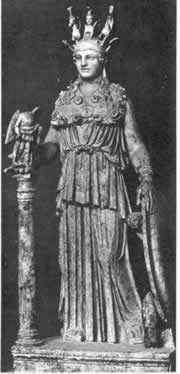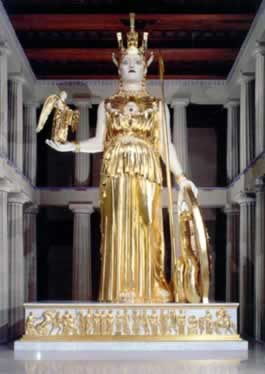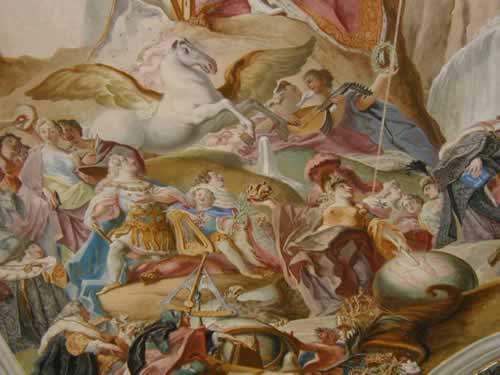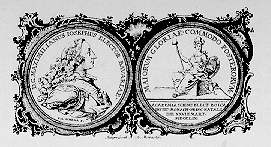|
ATHENA
DIVINE WISDOM
by Evan Randolph
|

Athena Parthenos, Greek goddess of Wisdom.
(Parthenos means Virgin). This statue reproduces, with a slight
variation in posture, the celebrated Athena Parthenos by Phidias
in the Parthenon. The huge statue, approx. 42 feet tall,
dominated the interior of the Parthenon in Athens, Greece.
Athena's dress was covered in gold. She held a shield upright
with a snake coiled within it; the other hand held a Nike (Victory).
Phidias' massive statue of Athena stood in the Parthenon 438
BCE until 429 CE, a total of 867 years.The reproduction
above is 2nd century CE. Athens Museum.
New Larousse Encyclopedia of Mythology, p. 107

This
full-scale replica of Athena Parthenos, Greek goddess
of Wisdom, is 41 feet 10 inches tall, and weighs 12
tons. The goddess of victory in Athena's right hand is 6 feet
4 inches tall. (see Footnote A-1 ref Athena statue)
Located in Nashville, TN, Athena Parthenos is the centerpiece
of a full scale replica of the ancient Parthenon.
(see Footnote A-2 ref Parthenon, Nashville)
MYSTERY--WHO HID DIVINE WISDOM?
Paul of Tarsus gives us three clues in his first letter to the
Corinthians. First, he mentions "...God's hidden wisdom..."
(1 Corinthians 2:7). This alerts us to the fact that for reasons
unclear, someone has hidden wisdom.
His next clue tells us that wisdom is a Greek, not a Jewish
phenomenon: "...Jews call for miracles, Greeks look
for wisdom..." (1 Corinthians 1:23).
Concerning Jesus Christ, Paul states: "...God
has made him our wisdom..." (1 Corinthians 1:30). "...he
is the power of God and the wisdom of God..."
(1 Corinthians 1:24)
OUR wisdom suggests that for Christians, Christ is now "our"
wisdom.
OK, but what happened to the original Greek wisdom that is
hidden?
Who was this Greek wisdom?
And who hid wisdom?
THIS WEB SITE SEEKS TO SHED SOME LIGHT ON THIS MYSTERY
FINDINGS:
Statement A
 IN ANCIENT
GREECE- ATHENA, GODDESS OF WISDOM, WAS FAR FROM HIDDEN IN ANCIENT
GREECE- ATHENA, GODDESS OF WISDOM, WAS FAR FROM HIDDEN
 9,000
BC- We note that Plato (429-348 BCE) ascribes Athena
as the patron/parent/educator of Athens 9,000 years prior to
his time.(see Plato Timeaeus 23d footnote 1-A). Plato
states that the Goddess Athena is both "...a lover of
war and a lover of wisdom..." (see Plato Timaeus
24d footnote 1-A). 9,000
BC- We note that Plato (429-348 BCE) ascribes Athena
as the patron/parent/educator of Athens 9,000 years prior to
his time.(see Plato Timeaeus 23d footnote 1-A). Plato
states that the Goddess Athena is both "...a lover of
war and a lover of wisdom..." (see Plato Timaeus
24d footnote 1-A).
Plato Cratylus 407a-b - "The ancients seem to have
had the same belief about Athena as the interpreters
of Homer have now; for most of these, in commenting on
the poet, say that he represents Athena as mind (nous)
and intellect (dianoia); and the maker of names seems to have
had a similar conception of her, and indeed he gives her the
still higher title of "divine intelligence"
(hê theou noêsis), seeming to say: This is she
who has the mind of God (Theonoa)..."
(see footnote 2-2)
 Athena
was the protector of the city, under such surnames as
Polias or Poliouchos. (see footnote 10-1) Athena
was the protector of the city, under such surnames as
Polias or Poliouchos. (see footnote 10-1)
In addition to the protector of Athens, the Goddess Athena
protected such major cities as Constantinople (see footnote
10-2) and Rome (see footnote 10-3)
 800
BC- The Greek goddess of Wisdom Athena appeared 162
times in HOMER'S ODYSSEY. She came down from heaven and
provided significant help to Ulysses in his earthly travails.
(see footnote 1-1) 800
BC- The Greek goddess of Wisdom Athena appeared 162
times in HOMER'S ODYSSEY. She came down from heaven and
provided significant help to Ulysses in his earthly travails.
(see footnote 1-1)
Statement 1
 We
note five key attributes in Homer's Odyssey attributed to Athena,
Goddess of Wisdom, that are common to Divine Wisdom in later
Jewish Wisdom texts. We
note five key attributes in Homer's Odyssey attributed to Athena,
Goddess of Wisdom, that are common to Divine Wisdom in later
Jewish Wisdom texts.
Click for supporting documentation
Statement 2
 300-100
BCE- We suspect Jewish OT Biblical writers "hid"
Athena by taking Her deeds and re-labeling them as deeds of
Divine Wisdom. 300-100
BCE- We suspect Jewish OT Biblical writers "hid"
Athena by taking Her deeds and re-labeling them as deeds of
Divine Wisdom.
Click here for supporting
documentation
Statement 3
 210 CE--Early
Christians were worried about Homer. Why? 210 CE--Early
Christians were worried about Homer. Why?
CHRISTIAN GNOSTICS "MAGNIFY HOMER AS THEIR PROPHET..."
so states Hippolytus, literalist Christian heresy hunter in
his ca 210 Refutations of all Heresies, book 5, chapter 3 (see
footnote 6-1)
Statement 4
 429 CE--
Early Christians "hid" Athena, Goddess of Wisdom,
by destroying Her statue in the Parthenon. 429 CE--
Early Christians "hid" Athena, Goddess of Wisdom,
by destroying Her statue in the Parthenon.
Athena installed in her Temple the Parthenon in Athens
in 438 BCE, atop the Acropolis. (see footnote 3-1)
Athena (42 foot tall statue) remained enshrined inside the Parthenon
until 429 CE (a total of 867 years), when "The Temple of
Goddess Athena (Parthenon) on the Acropolis of Athens is sacked."
(see Footnote 3-2)
"The Christians, under the emperor Theodosius II, removed
the statue to Byzantium, where it was stripped of its
gold and destroyed without a trace." (see Footnote 3-3)
Statement 5
 527-565
CE- CHRISTIAN ROMAN EMPEROR JUSTINIAN (RULING FROM CONSTANTINOPLE)
EMBRACED CLASSICAL GREEK THINKING---he built the magnificant
church Hagia Sofia (Divine Wisdom) in Constantinople which was
described at the time using thinly veiled references to Athena. 527-565
CE- CHRISTIAN ROMAN EMPEROR JUSTINIAN (RULING FROM CONSTANTINOPLE)
EMBRACED CLASSICAL GREEK THINKING---he built the magnificant
church Hagia Sofia (Divine Wisdom) in Constantinople which was
described at the time using thinly veiled references to Athena.
Click here for supporting
documentation
Statement 6
 630
CE- ATHENA'S TEMPLE NAMED AFTER DIVINE WISDOM-- 630
CE- ATHENA'S TEMPLE NAMED AFTER DIVINE WISDOM--
"The most important symbol of Greek heathenism, the Parthenon,
was changed in the seventh century into a church for Aghia
Sophia, the divine wisdom..."
(see footnote 9-1)
"It is by no means coincidence that the chief temples of
Pagan Athens and Christian Constantinople were both dedicated
to Wisdom. The Parthenon as the shrine of the Goddess
Athena, Goddess of Wisdom, and Justinian's Great Church both
showed respect for "Sophia" which has always been
one of the chief traits of the Greek mind.
(see footnote 9-2)
In a 2001 trip to Greece, I noted little or no references
to Athena, 867 year resident of the Parthenon. As I recall,
I had to grab a docent at an Athens musueum and get her to take
me to a locked room in the back, where I was shown the Athena
statue. This was the only time I saw or heard of Athena on a
week long Greek trip (Athena is pretty well "hidden").
Statement 7
 1204 CE---Roman
Christians "hide" the treasures of Agia Sophia by
sacking the place--- 1204 CE---Roman
Christians "hide" the treasures of Agia Sophia by
sacking the place---
"After conquering Zara, the Crusaders diverted to Constantinople
rather than sail on to the Holy Land. They and the Venetians
attacked Constantinople, the richest Christian city in the world.
They plundered the city and took its wealth,
including the treasures of the great church Hagia Sophia.
They battled against other Christian men and they raped Christian
women.
The conquering of the great Christian city in 1204 ended the
Fourth Crusade and had significant religious and political
consequences. A number of Latin states were established in Greece
and the Aegean; the communion between Roman
Catholic and Orthodox Churches ended. The Byzantine government
moved to Nicea. Likewise most of the Greek bishops
abandoned their sees and took refuge at Nicea, leaving their
churches to the Latin bishops; Greek convents were replaced
by Cistercian monasteries." (see Footnote 8-4)
The antics of Opus Dei in THE DA VINCI CODE fall into a pattern
somewhat consistent with the sacking of the Parthenon and Hagia
Sophia by the Roman Christians.
|
|
Statement 8
 412-485
CE- Proclus "finds" Athena, Goddess of Wisdom 412-485
CE- Proclus "finds" Athena, Goddess of Wisdom
In my internet searches I uncovered a 5th century philosopher
named PROCLUS (412-485 CE). Born in
Byzantium/Constantinople, Proclus felt the Goddess Athena
appeared to him early in his life, urging him to study
philosophy, and later imploring that he move to Athens. He followed
her urgings, and eventually became the leader of Plato's Academy
in Athens.While at the Academy, Proclus became familiar with
the mysteries of Theurgy (see definition below). When the
Goddess Athena was removed from the Parthenon by the Christians,
she appeared to Proclus and said "they turned me out of
my Temple, now I come to live with you. Since then She lives
in our homes and our hearts." (see footnote 11-1)
Proclus was a pagan, and his world was under attack by the Christians,
who at this time (314-860 CE ) were in the process of destroying
Pagan Temples, burning all non-Christian books, and killing
pagan spiritual leaders. The Christians under Emperor Theodsius
sacked the Parthenon in 429 CE. (see footnote 11-2 )
Proclus wrote a poem to Athena imploring Her to save him. (see
footnote 11-3) His life was clearly in danger. (We note
Proclus died of old age at the Academy in 485 CE--see footnote
11-1).
What were the mysteries of Theurgy practiced by Proclus?
(see footnote 12-1)
"Theurgy, from the Greek theourgia, means literally something
like 'actuating the divine' and refers to actions that
induce or bring about the presence of a divine or supernatural
being, whether in an artifact or a person...The practice was
commended and followed, in the third and later centuries, by
certain Neoplatonist philosophers and their disciples."
(see footnote 12-1)
Proclus, who felt himself in communication with Athena, was
probably trying to articulate the phenomenon (shown so clearly
by Homer) of Odysseus being assisted by Athena.
Statement 9
 Athena
appears in Catholic Church fresco (although labelled otherwise
by locals-She is semi-hidden) Athena
appears in Catholic Church fresco (although labelled otherwise
by locals-She is semi-hidden)
The Catholic Church of Maria de Victoria, Ingolstadt, Bavaria,
Germany has an interesting group of frescoes as described by
Thomas Schipflinger in his book SOPHIA-MARIA. A HOLISTIC VISION
OF CREATION. Schipflinger states on page 183: "Its frescoes
were painted by Cosmas Damien Asam in 1734. The ceiling fresco
in the entrance hall portrays Wisdom sitting on a throne amidst
royal insignia... Depicted as a Queen, Sophia carries a staff
and also a scepter in the form of a snake...The scepter in the
form of a snake symbolizes Sophia's healing and salvation-bringing
power (the snake is a symbol of Wisdom and healing)."
[Please note snake with Athena in Parthenon statue- see top]
"The entrance hall fresco represents a kind of "prologue"
to the ceiling fresco inside the church... There one sees a
beam of light descending from God the Father to a woman dressed
like Sophia in the entrance hall painting... From Her another
beam descends down to Mary, who is kneeling in assent to the
message that She is to be the Mother of God... It is further
interesting to note that the beam of light reflected to Mary
is in turn reflected by Her down to... Pallas Athena, the
Greek goddess of Wisdom..." (see subject fresco below)
Verlag Donau Kurier in his book COSMAS DAMIEN ASAM. MARIA DE
VICTORIA. INGOLSTADT comments on page 105 (translated from German)
below a picture of Athena: "Hit by the holy beam of light:
Pallas Athene, Europe..."
The nearby copy reads: "The Jesuit description from 1735
in view of the woman in Pallas' golden armour... She is identified
as Pallas by her armour and helmet. Pallas is the
goddess of Wisdom, Mary as the seat of Wisdom is also in
this respect the saintly Pallas. Pallas and Minerva were, in
antiquity and the baroque period, quite often identified with
one another. Minerva also represents Wisdom, but also faith,
justice, innocence, grace, and devotion to Mary..." (see
subject fresco below)
KEY 1735 STATEMENT--"PALLAS IS THE GODDESS OF WISDOM,
MARY IS THE SEAT OF WISDOM"

Copyright of "Kurt Scheuerer,
Ingolstadt, Bavaria" and: kurt@scheuerer-ingolstadt.de
I believe this 1734 painting also depicts the Duke of Bavaria
Charles VII with his 7 year old son Maxmillian III Joseph.
It appears Athena is passing the crown their direction.
25 years later the son was involved in the dedication of the
Bavarian Academy. Athena appears again.
"Dedication of volume I of the Proceedings (1763).
On the left a
portrait of Elector Maximilian III Joseph; on the right, Pallas
Athene
holding the 'heart-shield' (inescutcheon) with the motto 'Tendit
ad
aequum' granted to the Academy by the Elector, and, below, the
date of
foundation, 28th March 1759."

The Elector in 1759 looks like his father in the 1734 Maria
de Victoria painting. This appears on a German web site covering
the dedication of The Bavarian Academy in 1759 (see Footnote
13:1)
Statement 10
 Lets
reclaim some of Athena's passages in Biblical Wisdom Texts- Lets
reclaim some of Athena's passages in Biblical Wisdom Texts-
"Through me kings reign, and rulers decree what is
just;
by me rulers rule, and nobles, all who govern rightly,
I love those who love me,
and those who seek me diligently find me.
Riches and honor are with me,
enduring wealth and prosperity.
My fruit is better than gold, even fine gold,
and my yield than choice silver.
I walk in the way of righteousness,
along the paths of justice;
Endowing with wealth those who love me
and filling their treasuries." (NRSV Proverbs 8: 15-21)
I observe an Orphic Hymn to Athena states "And send
us necessary wealth and prosperity always."
(see Footnote 14-1) This Wisdom text echoes that earlier Orphic
Hymn.
"Wisdom has built her house,
she has hewn her seven pillars;
she has slaughtered her animals,
she has mixed her wine,
she has also set her table.
She has sent out her servant-girls,
she calls from the highest places in the town,
"You that are simple, turn in here!"
To those without sense she says'
"Come, eat my bread and drink the wine I have mixed.
Lay aside immaturity, and live, and walk in the way of insight.""
(NRSV Proverbs 9: 1-6)
Here we see an invitation from Athena in the Parthenon to
a pre Christian bread and wine communion to learn wisdom. She
is sending her servant-girls from the highest places in town
(Acropolis means "high point of the city"). This is
a Greek temple because women did not serve in Jerusalem's temples.
Philo of Alexandria (25 BCE-50 CE) likens Athena to the number
seven (see Footnote 14-2)- thus shedding light on the seven
pillars.
CONCLUSION-
 HIDDEN
WISDOM HAS BEEN FOUND. SHE HAS HER ROOTS IN GREEK CLASSICAL HIDDEN
WISDOM HAS BEEN FOUND. SHE HAS HER ROOTS IN GREEK CLASSICAL
THINKING AND HAS BEEN PERSONIFIED AS ATHENA, GODDESS OF WISDOM
FOOTNOTES:
Footnote A-1 for Athena statue replica Nashville
http://www.nashville.gov/parthenon/athena.htm
Footnote A-2 for Nashville Parthenon replica
http://www.nashville.gov/parthenon/index.htm
Footnote 1-A
http://www.goddess-athena.org/Museum/Texts/Plato_x.htm
Footnote1-1:
http://www.goddess-athena.org/Museum/Texts/Odyssey.htm
Footnote 2-1:
Jesus and the Lost Goddess, Timothy Freke & Peter Gandy,
p. 304
Footnote 2-2:
http://www.goddess-athena.org/Museum/Texts/Plato_x.htm
Footnote 3-1:
http://www.goddess-athena.org/Museum/Temples/Parthenon/index.htm
Footnote 3-2:
http://www.wcer.org/members/europe/Greece/persec.htm
Footnote 3-3: (see modern date: Nov 29)
http://www.clubs.psu.edu/up/aegsa/rome/nov26.htm
Footnote 4-1:
http://74.1911encyclopedia.org/P/PR/PROVERBS_BOOK_OF.htm
Footnote 4-2 (see item 6)
http://www.cs.utk.edu/~mclennan/BA/SA.html
Footnote 4-3:
http://www.goddess-athena.org/Museum/Sculptures/Group/Creation_of_first_man_Capitoline_x.htm
Footnote 4-4: (see end para 3)
http://www.goddess.ws/athena.html
Footnote 4-5 (see beginning para 3)
http://www.goddess.ws/athena.html
Footnote 4-6 (see para 5)
http://www.bellaonline.com/articles/art8904.asp
Footnote 4-7 (see Orphic Mysteries)
http://www.geoman.com/jim/ancientmystery.html
Footnote 6-1 (Book 5, chapter 3)
http://www.ccel.org/fathers2/ANF-05/anf05-09.htm
Footnote 7-1(see "Literature and the Arts", near bottom)
http://www.greece.org/Romiosini/constple.html
Footnote 8-1 (see "Literature and the Arts", nearer
bottom)
http://www.greece.org/Romiosini/constple.html
Footnote 8-2
http://86.1911encyclopedia.org/P/PA/PAULUS_SILENTIARIUS_.htm
Footnote 8-3
http://www.fordham.edu/halsall/source/paulsilent-hagsoph1.html
Footnote 8-4
http://gbgm-umc.org/umw/bible/sack.stm
Footnote 9-1 (para 2)
http://monolith.dnsalias.org/~marsares/acro/history/medieval.html
Footnote 9-2 (see "The Church of St. Sophia")
http://www.greece.org/Romiosini/constple.html
Footnote 10-1
http://www.echoedvoices.org/Jul2001/JulyGodMonth.html
Footnote 10-2
http://www.myriobiblos.gr/texts/english/constantelos_ab.html
Footnote 10-3 (see Palladium being carried off by Diomedes)
http://www.novabritannia.org/who_is_minerva.htm
Footnote 11-1 (see The Life of Proclus)
http://www.goddess-athena.org/Encyclopedia/Friends/Proclus/
Footnote 11-2
http://www.wcer.org/members/europe/Greece/persec.htm
Footnote 11-3
http://www.heliodromion.gr/e-orfikos_hymnos_athenas.htm
Footnote 12-1
http://www.granta.demon.co.uk/arsm/jg/hermes.html
Footnote 13-1
http://www.badw.de/englweb/eak2.htm
Footnote 14-1
http://www.sibyllinewicca.org/sacred_writing/sw_oh_athena.htm
Footnote 14-2
http://ccat.sas.upenn.edu/rs/rak/courses/999/moehring.htm
|
|



